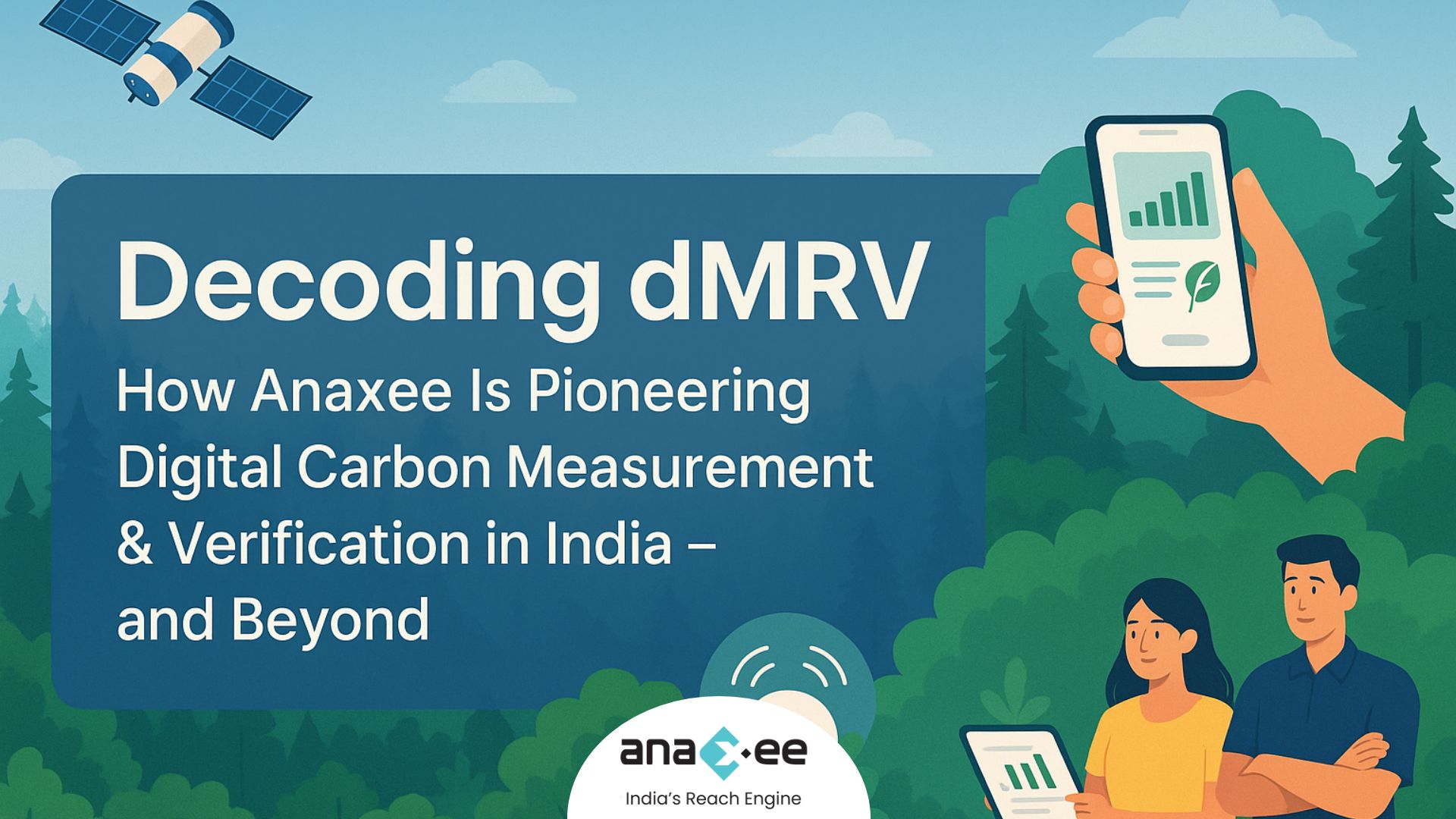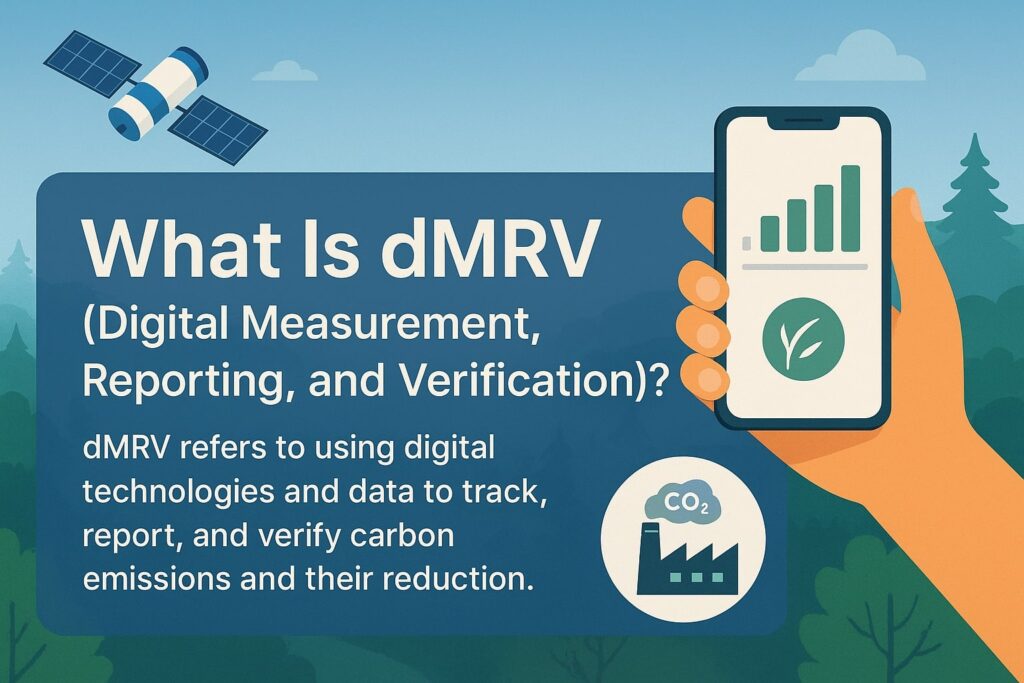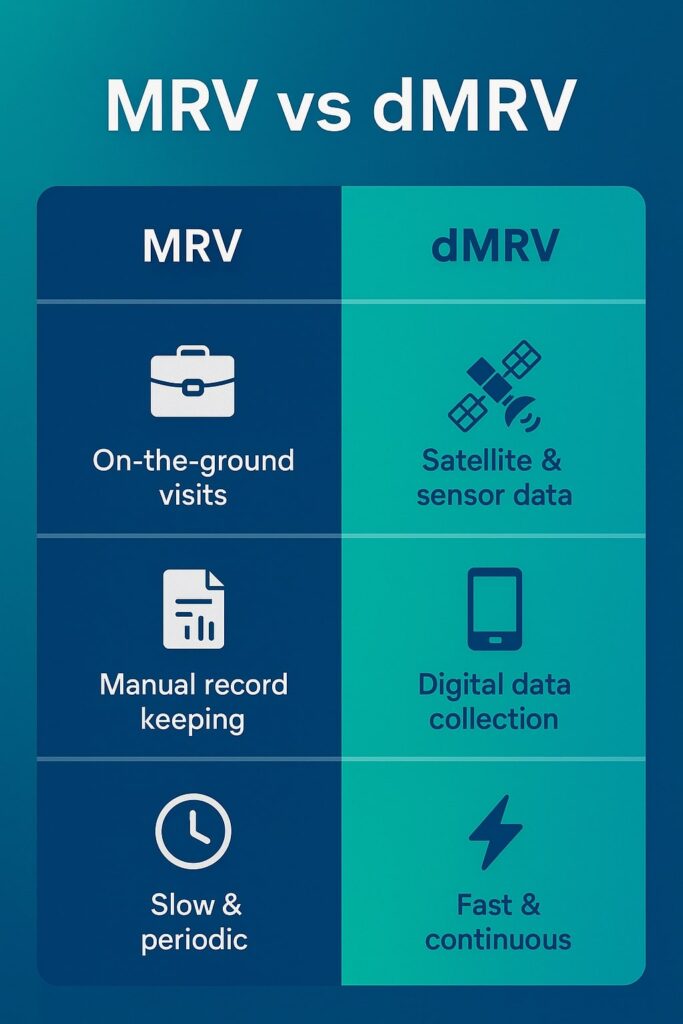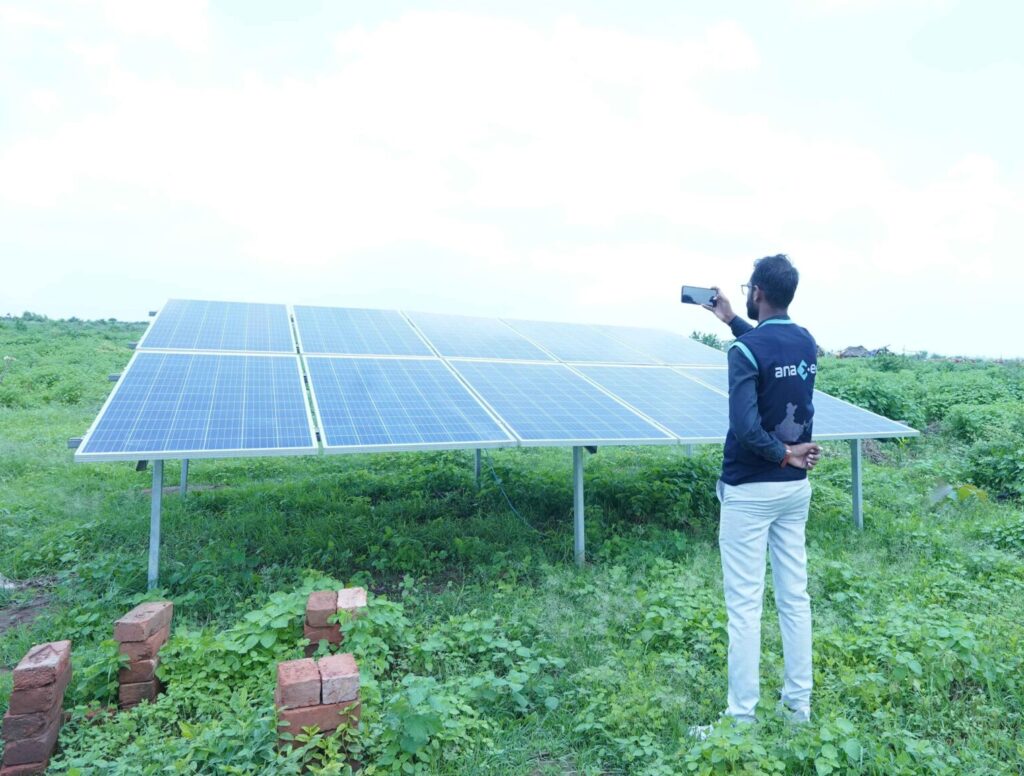BLOG

Decoding dMRV: How Anaxee Is Pioneering Digital Carbon Measurement & Verification in India – and Beyond
Digital MRV (dMRV) is reshaping how carbon projects are measured and verified. India‑born Anaxee Digital Runners has built the country’s largest last‑mile data network, marrying human reach with satellite, sensor and AI workflows to cut verification costs by up to 70 % while speeding credit issuance by months. This in‑depth guide explores dMRV fundamentals, the global pivot to digitisation, India’s unique opportunity, and real‑world case studies of how Anaxee delivers trust and scale.

1. Introduction: The Race for Credible Carbon Data
The global carbon market crossed USD 1 trillion in traded value in 2024, yet more than one‑third of credits were flagged for quality concerns. Investors, corporates and regulators now demand evidence‑based impact before they will buy, retire or account for a tonne of CO₂e. Traditional monitoring, reporting and verification (MRV) models – clipboards, paper forms, sporadic field visits – simply can’t keep up. Enter digital MRV (dMRV): a technology‑driven framework that streams geospatial, sensor and human‑validated data in near real‑time, automates analytics and slashes subjectivity.
If MRV was the carbon market’s “trust but verify” mantra, dMRV upgrades it to “trust because you can verify at any time.” For climate projects operating across thousands of villages and hectares, the difference is transformative: lower verification costs, faster credit issuance and, most importantly, heightened credibility in the eyes of buyers and auditors.
In this long‑form guide (≈4,000 words), we unpack what dMRV really means, why it is rapidly becoming the new norm, and how Anaxee Digital Runners – an Indore‑based deep‑tech company – has emerged as a trailblazer powering India’s most ambitious nature‑based and household‑level carbon projects.
2. MRV vs dMRV –

A Quick Primer Measurement, Reporting & Verification (MRV) dates back to the Kyoto Protocol. It prescribes that every carbon project must:
- Measure baseline emissions and subsequent reductions or removals.
- Report findings in an auditable format.
- Verify data through a third‑party accredited body.
While robust in principle, legacy MRV workflows rely heavily on manual sampling and periodic site visits. A 2024 study by the LSE Grantham Institute estimated that up to 20 % of project costs can be swallowed by MRV overheads.
Enter dMRV
Digital MRV layers modern tech on top of the three pillars:
-Remote sensing & drones to capture canopy height, biomass and land‑use change.
-IoT sensors (soil probes, smart cook‑stove meters) for continuous data feeds.
-Machine learning to convert raw pixels and sensor noise into emissions factors.
-Blockchain or distributed ledgers for tamper‑proof records and transparent audit trails.
Key stat: A Gold Standard working group found that dMRV can cut verification costs by 40–70 % and compress credit issuance cycles by up to 12 months.
With market mechanisms like Article 6 of the Paris Agreement demanding ever faster, globally comparable data, dMRV is gaining near‑mandatory status.
3. Why dMRV Matters to the Voluntary & Compliance Carbon Markets
3.1 Speed
Faster verification means carbon revenues hit project developers’ accounts sooner, improving cash flow and enabling reinvestment in community benefits.
3.2 Accuracy & Integrity
Continuous monitoring reduces the risk of over‑ or under‑crediting. Transparent, tamper‑proof data logs improve buyer confidence and comply with stringent registries.
3.3 Scale
With automated analytics, a single verifier can oversee dozens of projects simultaneously, unlocking economies of scale previously impossible.
3.4 Equity
Lower transaction costs open the door for smallholder farmers, village bodies and micro‑entrepreneurs to participate in carbon markets – a game‑changer for rural economies.
4. The Global dMRV Landscape in 2025 From Silicon Valley start‑ups to UN‑backed think tanks, the race to build ‘infrastructure for trust’ is heating up.
| Region | Notable Players | Signature Tech | Focus Sector |
| North America | Pachama, Regrow Ag | LiDAR + AI Forest Models | Forestry & Agriculture |
| Europe | Sylvera, Climate Trace | Satellites + ML | Global MRV Scoring |
| Africa | BURN Manufacturing | Smart‑metered cook‑stoves | Household Energy |
| Asia | Green Carbon, Netra Tech | Methane Sensors + Blockchain | Rice & Blue Carbon |
India is fast emerging as the largest testbed for scalable dMRV, thanks to its vast rural landscapes, smartphone penetration and proactive policy support.
5. India’s Moment: Policy, Demand & Innovation
- National Green Credit Programme (2023) – incentivises biodiversity, water conservation and carbon sequestration projects, all requiring stringent MRV.
- Startup India & Digital Public Goods – zero‑rating of GST on carbon credits and sandboxes for climate‑tech pilots.
- Corporate Net‑Zero Rush – Over 160 Indian companies have SBTi‑approved targets, driving demand for high‑quality local credits.
Combined, these forces make India ground zero for dMRV experimentation – and Anaxee sits squarely at the intersection of tech capability and last‑mile reach.
6. Meet Anaxee:
India’s Largest Last‑Mile Climate Data Infrastructure Founded in 2016, Anaxee Digital Runners began as a distributed field‑data platform for banks and FMCG giants. Today, its 40,000‑strong ‘Digital Runners’ network covers 26 states, 7,000+ pin codes and 120,000 villages, making it India’s deepest boots‑on‑the‑ground data operation.
6.1 Core Strengths
-Human + Digital Hybrid: Runners validate satellite insights with geo‑tagged photos, ensuring on‑ground reality matches remote sensing output.
-Real‑Time Data Pipelines: A cloud dashboard visualises every tree, stove or sensor in near real‑time for project owners and auditors.
-Local Empowerment: Village‑level micro‑entrepreneurs earn revenue for each data task, injecting income into rural economies.
7. Inside Anaxee’s dMRV Stack – People + Platform + Partnerships
| Layer | Components | Value Add |
| Acquisition | Drone & satellite feeds, IoT probes, mobile app surveys | Multi‑modal data lowers sampling bias |
| Processing | AI tree‑species detection, sensor QA/QC, leakage algorithms | Converts raw data into verified emission factors |
| Ledger | Hyperledger‑fabric nodes + IPFS storage | Immutable, auditable records satisfy registry requirements |
| Interface | Custom dashboards, client APIs, automated auditor log‑ins | Transparency for corporates, registries, communities |
Strategic tie‑ups with ISRO’s Bhuvan Portal and Azure FarmBeats provide high‑resolution imagery and agronomic models, while an MoU with IIT Kharagpur advances AI species‑classification.
8. Project Snapshots: Agroforestry, Clean Cooking & Mangroves
8.1 Trees Outside Forests (TOF)
-Area: 12,000 ha across 45 villages in Maharashtra.
-Data Points: 2.8 million trees monitored via UAV + mobile app surveys.
-Outcome: Verification cost ₹52/ha/year vs ₹380 in manual MRV; first 50,000 credits issued in 11 months (70 % faster).
8.2 Clean Cooking for Tribal Households
-Scale: 60,000 smart‑metered LPG connections in Madhya Pradesh.
-dMRV Edge: Burner‑level sensors push usage data every 30 minutes, validated by monthly Runner visits.
-Impact: Average 1.6 tCO₂e avoided per household per year; credit payments disbursed via UPI.
8.3 Mangrove Restoration, Sundarbans Delta
-Area: 3,500 ha degraded coastline.
-Tech: Sentinel‑2 NDVI change detection + community photo transects.
-Projected Benefit: 1.2 million tonnes CO₂e removed over 30 years; blue‑carbon warrant enables upfront financing.
9. Overcoming dMRV Challenges – Data Quality, Leakage & Permanence
-Sensor Drift & Calibration – Anaxee installs dual sensors per site and cross‑checks against Runner‑captured readings.
-Leakage Detection – Geofenced alerts flag land‑use change in buffer zones within 72 hours for corrective action.
-Permanence Risk – Parametric insurance via blockchain smart contracts auto‑pays for replanting if cyclones or fires are detected.
-Data Privacy – Differential‑privacy algorithms anonymise household‑level data while preserving aggregate accuracy.
10. Future Outlook: Article 6, Tokenisation & AI Automation
-Article 6 Trust Layer: With UN supervisory bodies signalling digital reporting templates, Anaxee’s modular APIs are Article 6‑ready.
-Instant Settlement: Tokenised credits on public‑permitted chains enable near‑instant payouts to smallholders.
-AI‑First MRV: Multispectral AI models will auto‑identify species and growth anomalies, enabling predictive maintenance of carbon assets.
-Global Expansion: Pilot projects in Kenya and Brazil leverage partner Runner networks under a franchise model.
11. Conclusion & Call to Action:
The carbon market is no longer just about planting trees or switching fuels; it’s about proving, continuously and transparently, that those interventions work. Digital MRV is the engine of that proof, and Anaxee has built a uniquely Indian – and globally relevant – engine room.
Whether you are a corporate chasing net‑zero, a project developer seeking scale, or an investor hungry for verifiable impact, Anaxee Digital Runners offers the people, platform and proof to deliver high‑integrity credits at speed.
➡️ Ready to unlock credible, scalable climate impact? Email sales@anaxee-wp-aug25-wordpress.dock.anaxee.com to schedule a demo.
12. About Anaxee:
Anaxee is India’s Reach Engine! we are building India’s largest last-mile outreach network of 100,000 Digital Runners (shared feet-on-street, tech-enabled) to help Businesses and Social Organizations scale to rural and semi-urban India, We operate in 26 states, 540+ districts, and 11,000+ pin codes in India.
We Help in last-mile execution of projects for (1) Corporates, (2) Agri-focused companies, (3) Climate, and (4) Social organizations. Using technology and people on-the-ground (our Digital Runners), we help in scale and execute projects across 100s of cities and bring 100% transparency in groundwork. We also work in the Tech for Climate domain, providing technology for the execution and monitoring of Nature-Based (NbS) and Community projects. Our technology & processes bring transparency and integrity into carbon projects across various methodologies (Agroforestry, Regen Agriculture, Solar devices, Improved Cookstoves, Water filters, LED lamps, etc.) worldwide.



